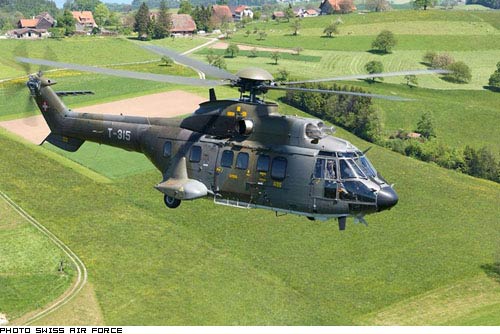H225M / EC725 Caracal
Summary
| Category | Military Helicopter |
| Origin country | 🇩🇪 Germany 🇫🇷 France |
| Manufacturer | Airbus Helicopters |
| First flight | 27 November 2000 |
| Year introduced | 2005 |
| Number produced | 90 units |
| Average unit price | $70 million |
Description
The Eurocopter EC725, later designated Airbus Helicopters H225M, was developed following a French Air Force requirement for a dedicated Combat Search and Rescue helicopter. The French Air Force sought improvements over the AS 532 A2 Cougar, specifically greater engine power, enhanced flight endurance, and improved combat durability, based on trials conducted from 1996 to 1999. Eurocopter responded by developing a derivative of the AS 532, initially termed Cougar Mk II+, incorporating new mission equipment, autonomous avionics, and further modifications to meet the French specification. The first EC725 prototype performed its maiden flight on 27 November 2000 in Marignane and was publicly unveiled on 15 January 2001. Eurocopter also developed the EC225 as a civil counterpart. The French Air Force placed an initial order for six EC725s for Combat Search & Rescue, with the first delivered in February 2005, followed by an order for eight more in November 2002. By 2015, production lines for the H225M were operational in France and Brazil.
The EC725 design incorporates improvements over the Eurocopter AS 532 Cougar. It features a five-blade composite main rotor with a new airfoil shape aimed at reducing vibration levels. Removable armor plating can be fitted to protect personnel. The aircraft is powered by two Turbomeca Makila 1A4 turboshaft engines, mounted over the cabin, utilizing a dual-channel full authority digital engine control (FADEC) system. An anti-icing system can be fitted to support operations in very cold climates. Other enhancements include a reinforced main rotor gearbox and an all-glass cockpit equipped with an integrated display system featuring a digital map and active-matrix liquid-crystal displays.
The helicopter can be equipped with various military equipment and armaments. These include a pair of 7.62 mm FN MAG machine guns mounted within the forward left and right windows, or a pair of 68 mm Thales Brandt or Forges de Zeebrugge side-mounted rocket launchers, each holding 19 rockets. External armament combinations, such as gun pods, rocket pods, and Hellfire air-to-surface missiles, can be mounted via the HForce Generic Weapon System (GWS), integrated with a Thales Scorpion helmet-mounted sight display (HMSD) and a Wescam electro-optical sensor for targeting. The MU90 Impact aerial-launched torpedo and the Exocet anti-ship missile have also been integrated, specifically on Brazilian Navy EC725s. Brazilian EC725s are fitted with a Helibras-built countermeasures suite, providing chaff and flares. Thales has developed self-protection systems for French EC725s.
Less than six weeks after introduction, the French Air Force deployed three EC725s to Cyprus for civilian evacuation from Lebanon during Opération Baliste in 2006. Later the same year, EC725s were deployed to Afghanistan in support of coalition forces, operating from Kabul International Airport. These operational experiences led to upgrades in 2013, incorporating a new SAGEM forward-looking infrared sensor, door-mounted Nexter machine guns, and FADEC modifications for low-temperature operations. In 2008, Brazil committed to local production of 50 EC725s at the Helibras facility for its Navy, Air Force, and Army. Mexico became the second export customer in 2009, utilizing armed EC725s for civil security and transport missions; one aircraft sustained damage during Operation Jalisco in 2015. In 2014, the Royal Malaysian Air Force deployed its EC725s in the search for Malaysia Airlines Flight 370, demonstrating its utility in search and rescue operations, a role also highlighted during the 2015 Sabah earthquake.
Main Variants:
-
HM-4: The Brazilian Army designation for the EC725.
-
AH-15: The Brazilian Navy designation for an attack variant of the EC725.
-
UH-15/UH-15A: The Brazilian Navy designation for utility variants of the EC725.
-
H-36: The Brazilian Air Force designation for the EC725.
-
VH-36: The Brazilian Air Force designation for a VIP transport variant of the EC725.
Technical specifications
| Version: EC725 Caracal | |
|---|---|
| Crew | 1 pilot + 1 copilot |
| Operational range | 930 km (578 mi) |
| Maximum speed | 324 km/h (201 mph) |
| Wingspan | 16.2 m (53.1 ft) |
| Height | 4.6 m (15.1 ft) |
| Length | 19.5 m (64.0 ft) |
| Service ceiling | 6,100 m (20,013 ft) |
| Empty weight | 5,330 kg (11,751 lbs) |
| Max. takeoff weight | 11,200 kg (24,692 lbs) |
| Climb rate | 7.4 m/s (24.3 ft/s) |
| Powerplant | 2 × Turboméca Makila 2A1 turboshaft engines of 1,776 kW each |
Current operating countries
| Country | Units | ||
|---|---|---|---|

|
Brazil | 40 (+7) | |

|
Kuwait | 27 | |

|
France | 23 (+8) | |

|
Mexico | 15 (+4) | |

|
Indonesia | 14 (+2) | |

|
Singapore | 13 (+3) | |

|
Malaysia | 12 | |

|
Thailand | 12 | |

|
Hungary | 10 (+6) | |

|
Taiwan | 3 | |

|
Vietnam | 2 | |

|
Kazakhstan | 0 (+20) | |

|
Iraq | 0 (+12) | |

|
Netherlands | 0 (+12) | |
All operators

